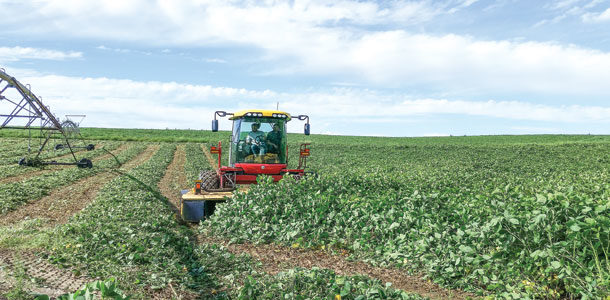Investigating means to reduce costs by limiting the number of cuttings is one approach. Low-lignin alfalfa hopes to reduce one cutting per year while maintaining quality. Nice idea, but what if you could eliminate three cuttings per year?
More difficult? Likely, so perhaps finding an alternative legume crop makes sense. This is what drew interest to rediscover soybean hay.
Soybeans were first widely used in the U.S. as a hay crop in the 1870s. By the 1900s, the USDA was encouraging production of soybeans as hay. Some early research showed soybean hay could match or exceed alfalfa hay for milk production in the eastern U.S.
Over time, soybean hay production has become almost non-existent as its popularity as an oil-seed crop has increased. A lot of research has been conducted on soybeans, and an infrastructure is well established, so it provides a lot for us to work with in redeveloping a soybean hay industry.
Much of the information on the Web concerning soybean hay stems from a soybean grain crop gone bad from drought, and producers are trying to salvage something, which may not provide a good picture of what can be accomplished.

Growing soybeans for hay is different than growing for grain. Even the number of herbicides and insecticides that can be used is different.
However, using Roundup Ready soybean varieties makes the herbicide decision easy unless you have glyphosate-resistant weeds. Whatever herbicide you use, make sure it is labeled for soybean hay production.
The first and probably the biggest decision in developing a successful soybean hay crop is selecting a variety to plant. For haymaking, select varieties without large seeds, as they will mold in hay.
Since all soybeans will produce seeds, harvesting at an early growth stage can help to minimize the problem. Research has shown that soybeans have their highest relative feed value (RFV) at flowering (R1), and then RFV decreases with maturity.
Palatability also declines as soybean matures and stems become higher in lignin and fiber. For silage or greenchop, a shorter-season variety would do just fine as the stems would be ground up and seed would not mold.
For areas like Washington (a maturity group 7), soybeans will never make seed and will give a higher forage yield at the R1 or full-flowering (R2) growth stage than earlier maturity groups and provide a large window in September for harvest. For comparison, soybean grain production in these areas would usually require a maturity group-1 soybean.
Areas farther south would need to select the latest maturity group bean that you can buy and harvest for hay before seed mold becomes a problem. A maturity group-7 soybean will achieve pod stage (R3) in Logan, Utah, by the end of September, with little seed development.
Soybean seed inoculation with proper inoculant Rhizobia japonicum prior to planting is a must if the field has not grown soybeans in the last three years.
If you grow soybeans without inoculating, expect protein levels to be half and a poor yield. In the Pacific Northwest, we have experienced problems with seed corn maggot attacking the seedling prior to and at emergence which has eliminated or reduced stands. We recommend a seed treatment with the full labeled rate of Cruzier Max to help protect seedlings during emergence.

In 2014, Jeb Whitby grew his first soybeans for hay in the Columbia Basin near Basin City, Washington, in two small irrigated fields about 10 acres each.
Whitby planted his Roundup Ready Gamekeeper under a pivot in early May, harvested on Aug. 28 and baled it seven days later on Sept. 4. It yielded 4.7 tons per acre.

Even though Whitby put Cruzier Max on his soybeans, his stand was reduced from 140,000 seeds per acre to about 70,000 plants per acre by the seed corn maggot. He had to stay on top of his weed control as weeds wanted to come into the stand, but he was successful.
Whitby was amazed at how little water the soybeans took, how well it filled in, and how fast the hay dried after cutting. Whitby said the soybeans dried much faster than sudangrass because the conditioner could crush the stem where it could not on the sudangrass due to the nodes being too tough.
After two days of windrow drying, Jeb spread the soybeans with a tedder, which covered the entire ground, and put it back into windrows two days before baling.
A second field harvested on Sept. 11 was baled on Sept. 22 which yielded similar to his first field. Currently, Jeb thinks soybeans fit best on his farm in a rotation after fall-planted triticale and before alfalfa.

Another farmer in Washington, Craig George, has grown soybeans for hay for two years near Ellensburg, at an elevation of 1,600 ft.
George is looking at soybeans as a rotational crop to go with his timothy hay to help control grassy weeds and break disease cycles between timothy hay crops. George grew Large Ladd variety and harvested 2.75 tons per acre this year on Aug. 27.

George’s soybean hay last year had a relative feed value of 174. Last year, George fed soybean hay to horses, goats, lambs and cattle, and says they all like it. What amazed me was that George said his horses preferred soybean hay to alfalfa hay.
In general, feed soybean hay just as you would alfalfa hay, as it may cause bloat with its high protein content. Use relative feed value, NDF and ADF to determine how good the hay is. Research has shown that RFV typically ranges from 120 to 175.
Cooperating WSU and USU Extension specialists and staff at the NIRS Consortium are working on developing NIRS equations for soybean hay quality and determining advantages and disadvantages of different maturity groups planted in Washington and Utah.

Yield data from these experiments ranged from 4 to 10.5 tons per acre. Selecting a group that matures too early can limit yield (Figure 1).
Averaged over locations, delaying harvest from Sept. 1 to Sept. 15 increased yield 0.8 ton per acre for maturity groups 4 and 7 and another 0.87 ton per acre waiting from Sept. 15 to Sept. 30.
Maturity group 4 at the end of September will have seed that fills the pod at Logan, Utah, and would slow down drying and may cause mold.
The top left picture on the preceding page shows 8-tons-per-acre soybean hay in research plots at Othello, Washington, in 2013. Yields at Othello ranged from 3.6 to 6 tons per acre in 2012 and 7.5 to 10.8 tons per acre in 2013.
Yields at Logan, Utah, ranged from 3 to 6.3 tons per acre in 2012 and 2.7 to 5.6 tons per acre in 2013. Data from these experiments show that late-maturing varieties continue to increase yield throughout September.
Soybeans become more profitable the farther you have to transport your equipment on roads due to decreased labor costs as well as decreased costs in three cuttings and two rakings, which amount to a savings of $80 per acre.
Increasing soybean yield potential may allow this rediscovered hay crop to compete directly with alfalfa for profitability in the irrigated West due to saved irrigation water and decreased harvesting costs. FG
Steve Norberg is a forage specialist with Washington State University and can be reached at s.norberg@wsu.edu; Earl Creech is an extension agronomist with Utah State University and can be reached at earl.creech@usu.edu.
PHOTOS
PHOTO 1: Swathing Gamekeeper soybeans on Jeb Whitby’s farm on Aug. 28, 2014.
PHOTO 2: Steve Norberg’s assistant Emanuel Farias stands next to research plots that yielded 8 tons per acre.
PHOTO 3: Jeb Whitby stands next to his soybean hay crop that yielded 4.7 tons per acre on Aug. 28, 2014.
PHOTO 4: Baling soybean hay into 1,100-pound large square bales on Whitby’s farm Sept. 4, 2014.
PHOTO 5: Craig George stands next to his 2.75-ton-per-acre soybean hay crop on Aug. 27, 2014.
PHOTO 6: Craig George’s soybean hay had a relative feed value of 174 on Aug. 27, 2013.











